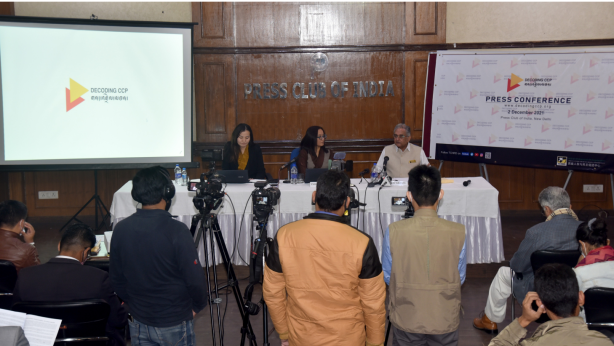‘WASTED LIVES’: New report offers fresh insights on travails of Tibetan nomads
Is there anything new that can be said about the disappearing nomads of Tibet? For years they have been removed from the plateau pastures that purify the great rivers of Asia, to be rehoused in concrete barracks, without their animals or livelihood. This is usually reported as coercion by a state determined to end nomadism. That has become a standard narrative. The alternative narrative, generated by China’s official media, is that the nomads are all voluntary ‘ecological migrants’ giving up their lands for the greater good of the planet, to allow degrading lands to become a wilderness of pristine grassland, to better protect those rivers watering almost all of Asia.
‘Wasted Lives: China’s Campaign to End Tibetan Nomadic Lifeways’ cuts through these stereotypes and extremes, with a wealth of new evidence. This co-publication by Tibetan Centre for Human Rights & Democracy (TCHRD) and League for Pastoral Peoples (LPP) takes the reader onto the pasture, to hear Tibetan voices. That is what has been strikingly missing till date.
Once we start to listen to what Tibetans can tell us, a new picture emerges, more complex and disturbing. The nomads tell of being pushed and pulled by a long history of official Chinese policies that aimed to intensify meat production while also conserving land and water. The unintended result of all the laws, regulations and instructions was to confine nomads to allocated parcels of land. Their customary mobility was restricted to areas compulsorily fenced, leaving nomads little flexibility, in an extreme climate, to maintain production on land that was thus pushed too hard, because choice was gone.
Not only did China’s sedentarisation policy perversely cause degradation, despite having quite different intentions, it also drove many nomads into poverty.
Land deteriorated, yak size shrank, land tenure was given and then taken away, with no social security to support nomads when natural disasters –blizzards and gales- strike.
Poor people have few choices. When the cadres come to the village, and announce that a fixed percentage of the population must move to barracks on the edge of a distant town, it is the poor, the chronically ill and those hoping a distant school gives their children a chance, who are the first to move. Whether this is voluntary or coercive is not the point: China uses push and pull, incentives and disincentives, to implement its policy of grazing bans and closing the best pasture lands in Tibet, which are on the headwaters of the Yellow and Yangtze Rivers.
BEYOND THE SAME OLD
What emerges in this retelling is not only the grief of skilled pastoralists who now lead wasted lives, redundant to the requirements of China’s commoditised meat machine, but also their hopeful embrace of a new paradigm sweeping the pastoral lands of the world.
A scientific revolution has quietly gathered momentum. Wherever there are pastoralists, there is now a fresh understanding that, far from being to blame for desertification, there are skilful stewards of drylands whose willingness to maintain mobility enables them to live productively and in environmentally sustainable ways from uncertain, unpredictable climates. In China, the biggest grassland country in the world, there are now Chinese scientists speaking up at every opportunity for the new paradigm, explaining how the old paradigm, of sedentarising nomads, has caused only perverse, unintended outcomes, chiefly the land degradation that is blamed on ignorant, uncaring, selfish nomads.
So a new story emerges, and a convergence between Chinese science challenging orthodoxy, and the voices of the nomads, not only protesting at wasting their lives as urban fringe dwellers with no entry into the modern economy, but looking ahead to the new pro-pastoralist paradigm renewing their stewardship. The scientists and the nomads agree that Tibetan nomads successfully conserved for huge wildlife herds of antelope and gazelles, for the hardy grasses of the alpine meadows for the past 9000 years, while also being highly productive. It is possible to be both sustainable and productive, it is not necessary to choose one to the exclusion of the other, as is happening now when pasturelands are declared nature reserves and national parks, excluding on paper all human use, in practice allowing illegal miners into the emptied, depopulated landscapes.
Not only does this report cut through the voluntary vs coercive debate, it introduces us to the voices of a new generation of Tibetan researchers, on the pasture, able to analyse past policy failures and look ahead to the latest initiative, by charismatic lamas deeply trusted by the nomads, urging nomads to refrain from selling animals into the slaughterhouse meat commodity chain. This return to public life of the lamas, despite restrictions, gives direction to nomads, who vow, in public ceremonies, to forego the quick gains of commercial slaughter for the traditional nomadic virtues of keeping as many beloved animals on the hoof as possible.
There is much that is new in this report; plenty to chew on for those who would like to see the vast rangelands of the Tibetan Plateau for themselves but cannot get access. Here is a way beyond the stereotypes of noble ecological migrant vs passive victim of coercion. There is much to tell the world.
The report was launched globally on 30 May 2015 in New Delhi. TCHRD director Tsering Tsomo, LPP’s projects coordinator Dr. Ilse Köhler-Rollefson and the report’s author Australian researcher and environmentalist Gabriel Lafitte addressed a press conference at Foreign Correspondents Club and spoke at a formal launch ceremony at India International Centre in New Delhi.
To download the report, click the download button below or click here.


